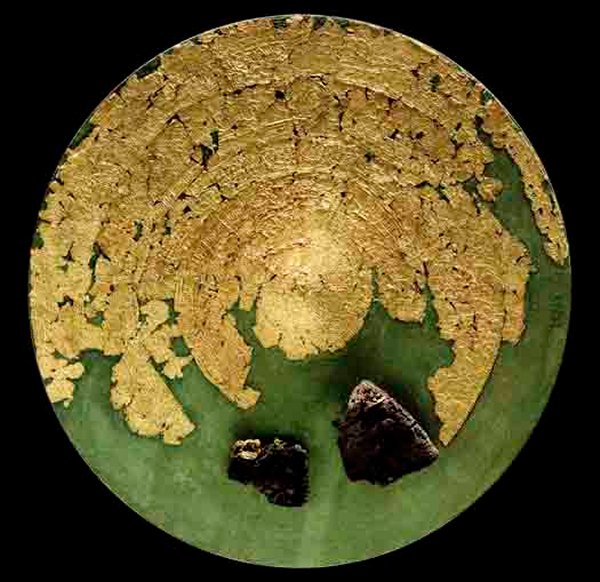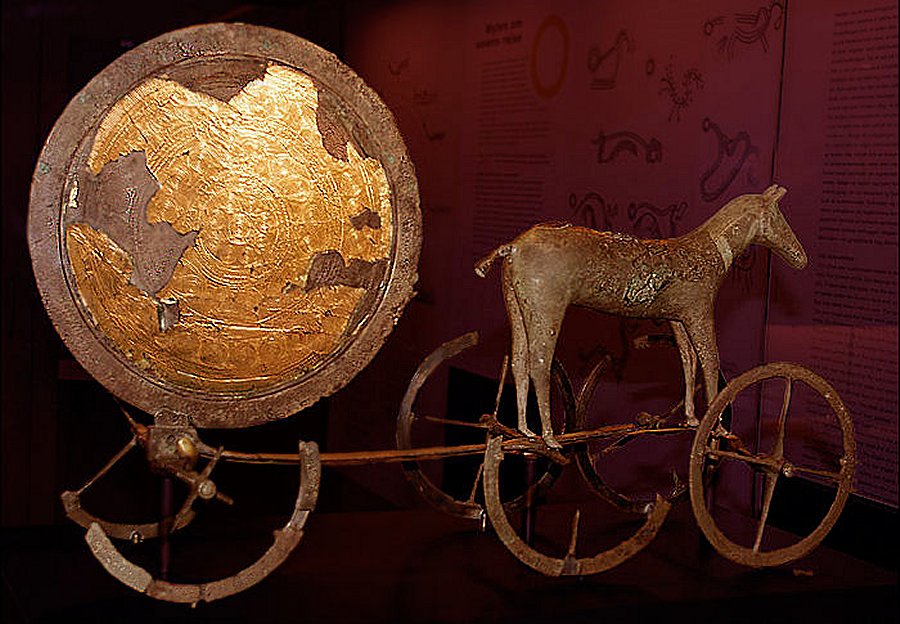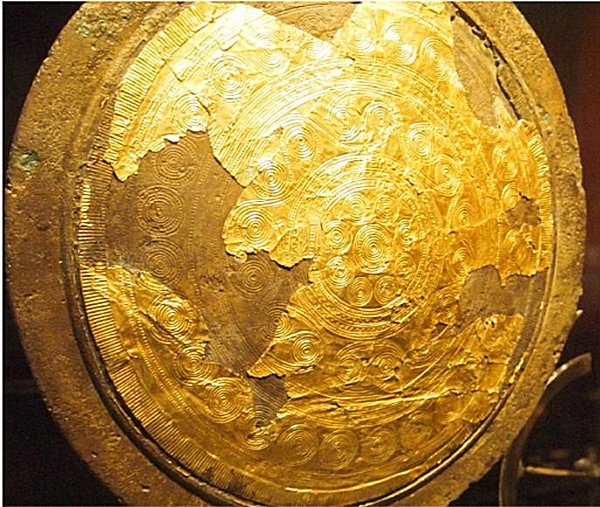Sun Chariot – Powerful Symbol Of Bronze Age Cosmology
A. Sutherland - AncientPages.com - The Sun Chariot - now in the collection of the National Museum of Denmark in Copenhagen - was found in September 1902 in a peat bog on the Trundholm moor in northwestern Zealand (Sjælland) - most populated island in Denmark.
The Sun Chariot - a beautiful example of prehistoric Northern European sculpture was made in the Early Bronze Age around 1400 BC.
The artifact's elegant spiral ornamentation that graces the golden sun disc reveals its Nordic origin.
The Sun Chariot consists of the solar disk, the axle, and four wheels with spokes and supports the idea that the sun was drawn on its eternal journey by a divine horse.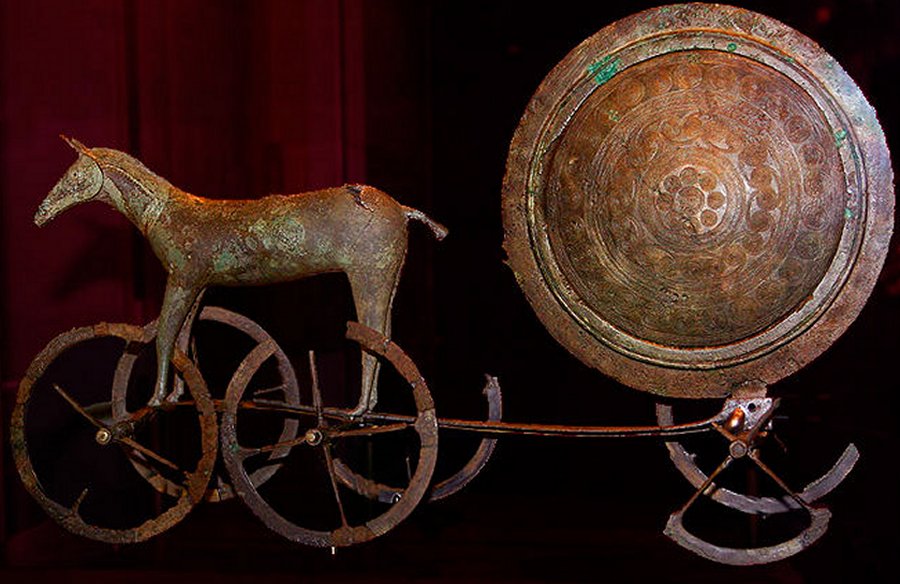
It is uncertain if the sun was imagined as being the chariot itself, or as riding in a chariot. Credits: natmus.dk
The bronze statue symbolizes the motion of the sun.
However, it is uncertain if the sun was imagined as being the chariot itself, or as riding in a chariot.
The Sun Chariot from Trundholm Mose was probably not the only one of its kind. Parts of a golden sun disc are amongst the finds from Jægersborg Hegn in northern Zealand. Perhaps it was originally part of a sun chariot?
The existence of a model of a horse-drawn vehicle on spoked wheels in Northern Europe at such an early time is very unusual, as the earliest known actual chariots (as opposed to ox-drawn carts without spokes) in Europe are from the Iron Age, dating from c. the 6th century BC.
The disk has a diameter of ca. 25 cm, and is gilded on only one side, the right-hand one relative to the horse.
What was the original function of ancient bronze disks with ornamentations? Could they had been ancient calendars?
The Sun Chariot was made in Denmark, most likely in northern or northwestern Zealand, not far from its finding place in Trundholm Mose. The image of the horse pulling the sun across the sky was familiar to most Scandinavians in the Bronze Age, but the complicated spirals seen on the disc of the Sun Chariot are very characteristic of the Danish area. The most beautiful and well-made spiral patterns are found on women's belt ornaments in northern Zealand - a fine example is the belt plate from Langstrup. Credits: natmus.dk
The Sun was the most powerful symbol of the Bronze Age cosmology in Denmark so the two sides of the disk are believed to be representations of the sun.
See also:
Eye Of Providence – Powerful, Secret Symbol With Deep Meaning
Ancient Symbol Hamsa: It’s Meaning And History Explained
This has been interpreted as an indication of the belief that the Sun is drawn across the heavens from East to West during the day, showing its bright side - the gilded one. During the night, it returns from West to East, showing his “dark side” to the Earth.
Looking at the disk we see decorations that are composed from several spirals, concentric circles and bands with zigzags.
What do they all mean?
The gilded solar face of the disk. Note the “rays” at the rim of the golden disk (Credit, adapted from a picture taken at the National Museum, Copenhagen Denmark, by Kim Bach)
The Sun chariot remains one of the most intriguing Bronze Age artifacts discovered in Denmark.
Written by – A. Sutherland AncientPages.com Staff Writer
Copyright © AncientPages.com All rights reserved. This material may not be published, broadcast, rewritten or redistributed in whole or part without the express written permission of AncientPages.com
More From Ancient Pages
-
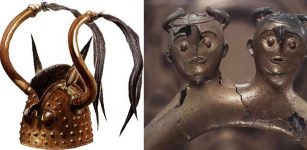 Mysterious Bronze Age Viksö Helmets With Horns Related To Myths, Holy Animals And Divine Power
Artifacts | Feb 27, 2018
Mysterious Bronze Age Viksö Helmets With Horns Related To Myths, Holy Animals And Divine Power
Artifacts | Feb 27, 2018 -
 Taharqa – The Most Powerful Of The Black Pharaohs
Featured Stories | Jan 29, 2016
Taharqa – The Most Powerful Of The Black Pharaohs
Featured Stories | Jan 29, 2016 -
 Celtic Valhalla And Sacred Wells – Magic Of Invisible Worlds
Celtic Mythology | Nov 17, 2021
Celtic Valhalla And Sacred Wells – Magic Of Invisible Worlds
Celtic Mythology | Nov 17, 2021 -
 Mystery Of The Forgotten Explorers And Ancient Artifacts That Re-Write History Of North And South America
Ancient Mysteries | Apr 13, 2020
Mystery Of The Forgotten Explorers And Ancient Artifacts That Re-Write History Of North And South America
Ancient Mysteries | Apr 13, 2020 -
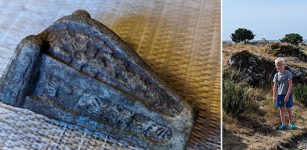 8-Year-Old Boy Finds Unusual Viking Age Artifact On Gotland Island, Sweden
Archaeology | Sep 18, 2023
8-Year-Old Boy Finds Unusual Viking Age Artifact On Gotland Island, Sweden
Archaeology | Sep 18, 2023 -
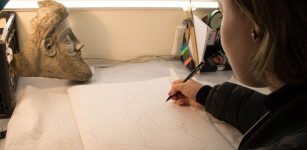 Fragment Of Unique Ancient Greek Terracotta Statue Uncovered In Underwater Diggings
Archaeology | Mar 26, 2017
Fragment Of Unique Ancient Greek Terracotta Statue Uncovered In Underwater Diggings
Archaeology | Mar 26, 2017 -
 Alexander The Great’s Mysterious And Unexplained Encounter In Babylon
Ancient Mysteries | Jul 15, 2021
Alexander The Great’s Mysterious And Unexplained Encounter In Babylon
Ancient Mysteries | Jul 15, 2021 -
 12 Masonic Symbols Explained
Ancient Symbols | Jul 2, 2018
12 Masonic Symbols Explained
Ancient Symbols | Jul 2, 2018 -
 Dozens Of Ancient Villages Discovered In British Columbia – The Pit Houses ‘Older Than The Pyramids’!
Archaeology | Apr 9, 2025
Dozens Of Ancient Villages Discovered In British Columbia – The Pit Houses ‘Older Than The Pyramids’!
Archaeology | Apr 9, 2025 -
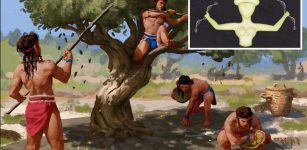 Ancient DNA Reveals “Completely Unexpected” Marriage Rules In Minoan Crete
Archaeology | Jan 16, 2023
Ancient DNA Reveals “Completely Unexpected” Marriage Rules In Minoan Crete
Archaeology | Jan 16, 2023 -
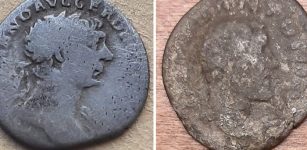 Unique Discovery – 2,000-Year-Old Roman Coins Found On Gotska Sandön In Sweden
Archaeology | Apr 13, 2023
Unique Discovery – 2,000-Year-Old Roman Coins Found On Gotska Sandön In Sweden
Archaeology | Apr 13, 2023 -
 Ancient Secrets Of The Amazon Jungle – Dangerous Expeditions And Hidden Treasures – Part 1
Ancient Mysteries | Mar 1, 2019
Ancient Secrets Of The Amazon Jungle – Dangerous Expeditions And Hidden Treasures – Part 1
Ancient Mysteries | Mar 1, 2019 -
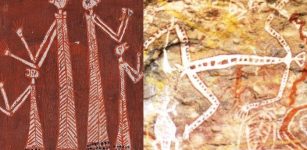 Immortal Mimi Spirits In Beliefs Of Aborigines Of Arnhem Land
Featured Stories | Mar 26, 2020
Immortal Mimi Spirits In Beliefs Of Aborigines Of Arnhem Land
Featured Stories | Mar 26, 2020 -
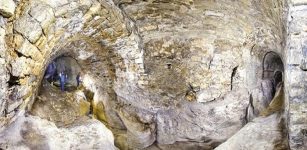 Centuries-Old Hidden Tunnels Will Be A New Tourist Attraction In Turkey
Archaeology | Apr 27, 2020
Centuries-Old Hidden Tunnels Will Be A New Tourist Attraction In Turkey
Archaeology | Apr 27, 2020 -
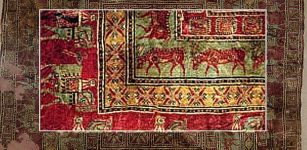 Pazyryk Carpet Found In Scythian Tomb Considered The Oldest Carpet In The World
Artifacts | Oct 5, 2016
Pazyryk Carpet Found In Scythian Tomb Considered The Oldest Carpet In The World
Artifacts | Oct 5, 2016 -
 How Was The 3,600-Year-Old Nebra Sky Disc Made? New Clues
Artifacts | Nov 29, 2024
How Was The 3,600-Year-Old Nebra Sky Disc Made? New Clues
Artifacts | Nov 29, 2024 -
 Perfectly Preserved Roman Tombs Discovered Near City Of Capua Where Spartacus Trained As Gladiator
Archaeology | Jan 7, 2021
Perfectly Preserved Roman Tombs Discovered Near City Of Capua Where Spartacus Trained As Gladiator
Archaeology | Jan 7, 2021 -
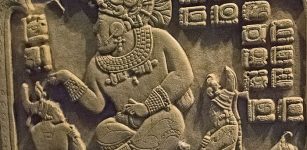 Fall Of The Ancient Maya Civilization Not Caused By Climate Change And Environmental Degradation – Scientists Say
Archaeology | Nov 18, 2021
Fall Of The Ancient Maya Civilization Not Caused By Climate Change And Environmental Degradation – Scientists Say
Archaeology | Nov 18, 2021 -
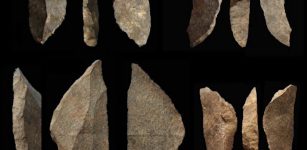 Prehistoric Swiss Army Knife Shows How Early humans Communicated
Archaeology | Jun 9, 2022
Prehistoric Swiss Army Knife Shows How Early humans Communicated
Archaeology | Jun 9, 2022 -
 Why Is The Hungry Ghost Festival Celebrated In August?
Ancient Traditions And Customs | Aug 12, 2019
Why Is The Hungry Ghost Festival Celebrated In August?
Ancient Traditions And Customs | Aug 12, 2019

